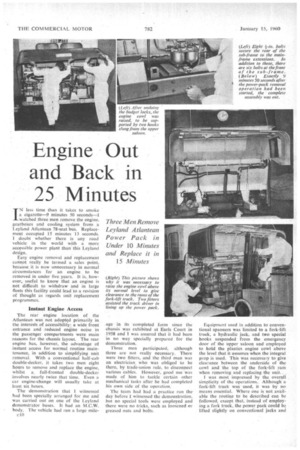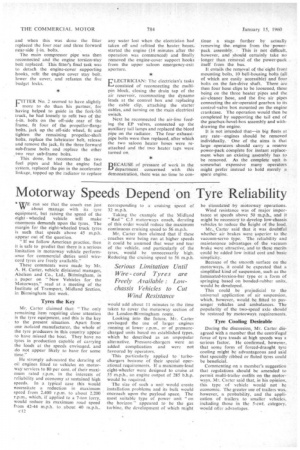Engine Out and Back in 25 Minutes
Page 48

Page 49

Page 50

If you've noticed an error in this article please click here to report it so we can fix it.
Three Men Remove Leyland Atlantean Power Pack in Under 10 Minutes and Replace it in 1 5 Minutes IN less time than it takes to smoke a cigarette-9 minutes 50 seconds--1 watched three men remove the engine, gearboxes and cooling system from a Leyland Atlantean 7g-seat bus. Replacement occupied 15 minutes 13 seconds. I doubt whether there is any road vehicle in the world with a more accessible power plant than this Leyland
design. .
Easy engine removal and replacement cannot really be termed a sales point, because it is now unnecessary in normal circumstances for an engine to be removed in under five years. It is, however, useful to know that an engine is not difficult to. withdraw and in large fleets this facility could lead to a revision of thought as regards unit replacement programmes.
Instant Engine Access
The rear engine location of the Atlantean was not adopted primarily in the interests of accessibility: a wide front entrance and reduced engine noise in the passenger compartments were main reasons for the chassis layout. The rear engine has, however, the advantage of instant access for normal routine maintenance, in addition to simplifying unit removal. With a conventional half-cab double-decker, it takes two men eight hours to remove and replace the engine, whilst a, full-fronted double-decker involves nearly twice that time. Even a car engine-change will usually take at least six hours.
The demonstration that I witnessed had been specially arranged for me and was carried out on one of the Leyland demonstrator buses. It had an M.C.W. body. The vehicle had run a large mile CIO age in its completed form since the chassis was exhibited at Earls Court in 1958 and I was assured that it had been in no way specially prepared for the demonstration.
Three men participated, although three are not really necessary. There were two fitters, and the third man was an electrician who was obliged to be there, by trade-union rule, to disconnect various cables. However, good use 'was made of him to tackle certain other mechanical tasks after he had completed his own side of the operation.
The team had had a practice run the day before I witnessed the demonstration, but no special tools were employed and there were no tricks, such as loosened or greased nuts and bolts. Equipment used in addition to conventional spanners was limited to a fork-lift truck, a hydraulic jack, and two special hooks suspended from the emergency door of the upper saloon and employed to hold the plastics engine cowl above the level that it assumes when the integral prop is used. This was necessary to give clearance between the underside of the cowl and the top of the fork-lift ram when removing and replacing the unit..
I was most impressed by the overall simplicity of the operations. Although a fork-lift truck was used, it was by no means essential. Where one is not available the routine to be described can be followed, except that, instead of employing a fork truck, the power pack could be lifted slightly on conventional jacks and the bus then pushed forward away from it.
To describe the operations carried out it is simplest to go through the procedure adopted by each man.
Unit Removal
FITTER No. 1: The first operation was to unfasten the engine cover, which is secured by five budget locks. This done, the engine cover was raised and supported on its prop. In the meantime, fitter No. 2 had lowered and secured the special hooks, so allowing the removal of the engine-cover-prop bolt.
With the cover fully raised, four of the fin, bolts securing the rear of.the powerpack sub-frame to the main frame were removed, after which the main air hose between the compressor and the reservoir pipe was disconnected. The fitter lay • underneath the vehicle for this, and while in this position he removed the three fin. bolts securing the . forward part of the sub-frame to the main frame.
Still under the vehicle, the bolt securing the engine torsion stay to the main frame was removed and the clevis pin at the rear of the accelerator-control linkage was withdrawn. This concluded this fitter's work, with the exception of helping to guide the fork-lift truck into position.
FNo. 2 started work by making two trips to the upper saloon with the special engine-coVer supporting hooks, whereupon he fitted these into position and took the weight of the engine cowl on them. On his way out he passed the driving compartment and released the hand brake and then went round to the off-side rear wheel, where he inserted the jack beneath the axle and jacked up the wheel. This was to allow him to turn the propeller shaft when removing the eight bolts securing it to the bevel-box output flange.
The three fin. bolts at the front end of the sub-frame were then removed, the eight propeller-shaft .bolts were slid out (after which the belt driving the automatic chassis lubricator was slipped off). and the jack was lowered and removed.
This fitter's final operation was to remove the four fin, bolts from the offside rear of the sub-frame, after which
he assisted the first fitter in guiding the fork-lift truck for the power-pack
removal.
ELECTRICIAN: The electrician's first task was to release the air from the reservoir. Then the main electrical switch was turned off and the two startermotor leads disconnected. Next, the main air pipe to the EP gearbox-control valves was removed, and the three dynamo wires were disconnected at the control box, which is carried on the rear
bulkhead. The clip supporting the dynamo wires was removed immediately after wards.
The multi-pin block of the main electrical harness was then withdrawn (this contains the leads for the electrically operated engine instruments, the starter solenoid and the engine-stop control) and the snap connectors for the two emergency tail lights were removed. The tail lights are located in the sub-frame and are to comply with legal requirements which would not otherwise be met when the engine cowl was raised on the road at night.
This completed the electrical side, so the electrician removed the four exhaustpipe securing bolts. After this the main fuel tap was turned off and the two fuel pipes between the tank and the lift pump were disconnected. The saloon heater tap at the radiator was turned off and the bleed-off pipe removed.
The heater tap adjacent to the engine water pump was then turned off, . Next, the two hoses joining the saloon heaters to the engine were disconnected, water leakage being prevented by inserting two tapered wooden plugs in the open ends of the hoses.
This complete operation lasted about 9 minutes and the remaining 59 seconds were occupied by placing the forks of the fork-lift truck under the sub-frame
Unit Replacement
FITTER No. 1 had first, in conjunction with the other fitter, to line up the power pack in relation to the main frame as the fork-lift truck approached the bus. The fork-lift operator lowered the power pack so that the underside of its sub-frame lined up with the main-frame prongs, and both fitters assisted by inserting bars through the rear bolt holes. Aligning the assembly occupied 3 minutes
and when this was done the fitter replaced the four rear and three forward near-side Fin. bolts.
The main compressor pipe was then reconnected and the engine torsion-stay bolt replaced. This fitter's final task was to detach the engine-cover supporting hooks, refit the engine cover stay bolt, lower the cover, and refasten the five budget locks.
FITTER No. 2 seemed to have slightly more to do than. his partner, for having helped to guide in the fork-lift truck, he had loosely to refit two of the +-in. bolts on the off-side rear of the frame, fit four of the propeller-flange bolts, jack up the off-side wheel, fit and tighten the remaining propeller-shaft bolts, replace the lubricator belt, release and remove the jack, fit the three forward sub-frame bolts and replace the other two rear sub-frame bolts.
This done, he reconnected the two fuel pipes and bled the engine fuel system, replaced the pin in the accelerater linkage, topped up the radiator to replace any water lost when the electrician had taken off and refitted the heater, hoses,started the engine (14 minutes after the operation was commenced) and finally removed the engine-cover support hooks from the upper saloon emergency-exit aperture.
E'LECTRICIAN: The electrician's tasks consisted of reconnecting the multipin block, closing the drain tap of the air reservoir, reconnecting the dynamo leads at the control box and replacing the cable clip, attaching the starter cables, and turning on the main electrical switch.
Next he reconnected the air-line feeding the EP valves, connected up the auxiliary tail lamps and replaced the bleed pipe on the radiator. The four exhaustpipe bolts were then replaced, after which the two saloon heater hoses were reattached and the' two heater taps were turned on.
BECAUSE of pressure of work in the department concerned with this demonstration, there was no time to con
tinue a stage further by actually removing the engine from the power pack assembly. This is not difficult, however, and should certainly take no longer than removal of the power-pack itself from the bus.
It entails the removal of the eight front mounting bolts, 10 bell-housing bolts (all of which are easily accessible) and four bolts on the fan-drive shaft. There are then four hose clips to be loosened, these being on the three heater pipes and the air-cleaner hose, and the five air pipes connecting the air-operated gearbox to its control-valve box mounted on the engine crankcase. The operation would then be completed by supporting the tail end of the gearbox-bevel-box assembly and withdrawing the engine.
It is not intended that—in big fleets at any rate—engines should be removed individually. One of the aims is that large operators should carry a reserve power-pack complete for instant replacement when an existing assembly has to be removed. As the complete unit is somewhat expensive many operators might prefer instead to hold merely a spare engine.












































































































